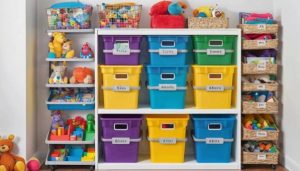Relocating with young kids does not have to be an ordeal. Methodical planning way ahead of the moving date like getting packing supplies and sorting childcare may help soften the transition. Indeed, constructing a timeline according to your kids’ schedule ensures their routine remains relatively unaffected. Furthermore, a detailed checklist encompassing pre-move, during, and post-move logistics including utilities switch and school notification simplifies everything. We start by talking about planning the move.
One essential tip for families with young children is to involve them in the state to state moving process as much as possible. This can include allowing them to pack their own belongings, or even letting them plan out their new room, giving them a sense of ownership and control. Additionally, arranging childcare for young children during the move and setting up their rooms as a priority after the move can also alleviate stress and make the transition smoother for the whole family.
Planning the Move
Moving is a substantial undertaking. It’s not just about choosing to reside in a different location; it’s about transforming your sense of comfort and security. Therefore, meticulous planning is essential when it comes to this significant change in your family’s life.
The first step involves setting a moving date. It’s crucial to consider various factors that might impact your move, such as work schedules, school terms, and even weather if you’re relocating across states or countries. You should aim for a day that allows ample time for preparations while minimizing disruption to your family’s routines.
Next up is researching moving companies. Finding a reputable moving company that aligns with your budget and has a track record of handling family moves is paramount. Looking at reviews and seeking recommendations from friends and family who have experience moving with children can help ensure a smoother transition.
While some may consider a DIY approach to avoid extra costs, professional movers can alleviate much of the stress and physical strain associated with moving with children. The time and energy saved can be invaluable during what’s already a very busy period.
Don’t overlook the importance of obtaining packing supplies too! You’ll need boxes, tape, bubble wrap, and labels. Consider checking out free resources for packing supplies such as recycling centers, local stores, or online community groups. Acquiring these items in advance can reduce stress in the days leading up to your move.
Packing supplies are like having all the right ingredients before starting a recipe. Just as you wouldn’t want to scramble for flour or sugar when you’re about to start baking, you don’t want to be searching for boxes when it’s time to pack.
Additionally, arranging for necessary childcare is crucial. Moving can be overwhelming and chaotic, especially for young children who might feel anxious or scared amidst all the commotion. Having someone look after your little ones during the heavy lifting and transport can alleviate stress for everyone involved.
By following these steps and planning ahead, you’ll ensure that the logistics of your move are well taken care of, allowing you to focus more on ensuring a smooth transition for your family into their new home.
As we’ve laid the groundwork for a successful move, let’s now shift our attention to the meticulous process of creating a comprehensive moving checklist to keep everything organized and on track.
Creating a Moving Checklist

Moving is a sizable task, but breaking it down into smaller, more manageable steps can make it feel less overwhelming. The best way to do this is by making a comprehensive moving checklist. This list will help you keep track of everything that needs to be done before, during, and after the move. Consider this checklist as your personal assistant – one that ensures no detail is overlooked.
Let’s start by breaking down the moving process into different categories: pre-move tasks, tasks for moving day, and post-move tasks.
Pre-Move Tasks
- Research and hire a reliable moving company.
- Declutter and donate unnecessary items.
- Notify schools and transfer records of your children.
- Schedule utility disconnections at your old home and reconnections at the new one.
- Set up a budget for the move.
Tasks for Moving Day
- Prepare packing supplies such as boxes, tape, and bubble wrap.
- Arrange for childcare or pet care during the actual move.
- Pack a “moving day essentials” box with snacks, drinks, important documents, and medications.
Post-Move Tasks
- Unpack and set up your new home.
- Meet your new neighbors and explore your new neighborhood.
- Update your address with relevant organizations and service providers.
To make things easier, consider using technology to manage your moving checklist. There are various apps and websites available that can help you create a digital list complete with reminders and notifications. Having a digital checklist can also allow all family members to access it from their devices and contribute to checking off completed tasks.
Once you’ve settled into your new home, it’s time to let your friends and family know about your move. Sending out “I’ve moved” cards is a thoughtful way to share your new address while adding a personal touch. Consider printing your cards on inkjet greeting card paper for a professional finish, ensuring they look polished and feel substantial. This small gesture can go a long way in staying connected and making your new place feel like home.
Imagine you have two months before the movers arrive at your doorstep – this checklist will guide you through each step of the process ensuring nothing is left behind. As you tick off each task, you’ll feel accomplished and ready for the next phase of the relocation journey.
By carefully planning out each step of the moving process, you can reduce stress and avoid any last-minute chaos. With this checklist in hand, you’ll be on your way to a smooth and organized relocation with minimal hiccups.
Preparing the Kids for the Move

Moving with children can be quite a challenge, and it’s crucial to be honest with them about the move and give them the time needed to process it. Showing them the new home and neighborhood is essential to help them become acquainted with the new space. Additionally, involving kids in family meetings and decision-making empowers them and alleviates any anxiety or fears they may have about the move.
It’s crucial to talk openly and positively to your children about the move. Address their concerns and validate their worries, taking into account their different ages. Being open to their perspectives allows them to express any anxieties they may have and share their thoughts.
Moreover, exploring the new area together can ease any apprehension they may have. Taking a family trip to the new neighborhood or town, highlighting places of interest, fun activities, and potential new friends, can make the unfamiliar environment feel less foreign. This fosters excitement and curiosity rather than just anxiety.
For example, take them to see local parks, playgrounds, or community centers where they might make friends or engage in activities they enjoy. You could also look for nearby attractions or events that align with their hobbies or interests.
By engaging your kids in open communication and allowing them to explore the new area, you’re actively involving them in the moving process and helping them adjust positively to the upcoming changes.
Understanding how to emotionally prepare your kids for the move is just one part of ensuring a smooth relocation. Next, we’ll focus on another critical aspect—organizing and packing kids’ belongings.
Organizing and Packing Kids’ Belongings

It can be overwhelming for children to see all of their familiar belongings disappear into boxes. To make the process less daunting, consider involving them in sorting and packing their own things. This not only gives them a sense of ownership over their possessions but also helps ease their anxiety.
Involving children in the packing process can be a great opportunity to build excitement about the move. Start by having a chat with your kids about how they want to pack their things. You can encourage them to choose a few special items to keep with them during the move, like a favorite toy, blanket, or book that provides comfort during this period of change.
Give your children small tasks based on their age to help with packing. For example, younger children can help toss soft items like stuffed animals into bins or bags, while older kids can sort through their books and decide which ones they want to keep close during the move. You could use colorful stickers or markers to label their boxes with their names and some decorations, making it exciting and giving them a sense of responsibility over their belongings throughout the moving process.
Once you’ve moved, involving them in decorating or arranging their new room can help them adjust better to their new environment. Letting them choose where certain things go, within reason, can give them a sense of control over their new space.
Encouraging your children to pack a “moving day survival kit” is another helpful strategy. It could include some of their favorite snacks, activities, and comfort items—a little adventure they’re excited to embark on!
By involving children in organizing and packing their belongings, parents empower them with a sense of control over the moving process, helping to alleviate some stress associated with relocation while also making it an exciting adventure.
Moving on from organizing and packing, let’s now shift our focus to the big day itself as well as making the new house feel like home for the little ones.
Moving Day and Unpacking

Moving day has arrived, and it can feel pretty hectic with all the boxes and people coming in and out of the house. One of the best things you can do is arrange childcare for the kids. This could be done by having someone look after them while you handle the moving process. It’ll help reduce stress for both you and the children.
If you don’t have family or friends available, consider hiring a babysitter or reaching out to a professional childcare service to ensure that your children are taken care of, so you can focus on overseeing the move.
Imagine having someone there to entertain the little ones while you’re focused on managing and supervising the move. It makes a world of difference.
Once you’ve arrived at your new home, prioritize setting up your children’s rooms first. Creating these comforting and familiar spaces will go a long way in helping your kids feel more at home in the new environment. Unpacking boxes can sometimes feel like an endless task, but focusing on your children’s rooms first will give them a sense of ownership over their space and help them adjust to their new surroundings.
The Importance of Familiar Spaces
Arranging their furniture, toys, and other belongings will give your kids a comforting area that feels like their own amidst all this change. Remember, moving can be quite overwhelming for children, so creating these familiar spaces will provide them with a sense of stability and comfort during this transition.
Additionally, involving your kids in setting up their rooms can give them a sense of control over their environment. Allow them to choose where they want certain things to go or let them decorate a part of their room to make it feel truly theirs.
By putting these steps into practice, you’re helping to alleviate some of the stress of moving day while also ensuring that your kids have a smooth transition into their new home.
As you continue on this journey towards settling into your new home, let’s explore the strategies for staying organized and avoiding stress during this period of adjustment.
Staying Organized & Avoiding Stress

Moving is never easy, especially when kids are involved. It’s a time of change, but that doesn’t mean it has to be chaotic. In fact, staying organized can help things run smoother for everyone—for you, your partner, and especially for the little ones whose routines are being disrupted.
Maintaining Routines
Children thrive on routine, and during moves, maintaining these familiar patterns can provide them with the consistency and security they crave during a period of change. Amongst all the packing and unpacking, try to keep meal times, bedtimes, and playtimes as consistent as possible. If it’s their favorite Saturday morning cartoons or a bedtime story before bed, these little moments can offer a sense of normalcy in an otherwise hectic time. While it may not entirely erase the stress of moving, following familiar schedules can go a long way in bringing comfort to your children during the transition.
Utilizing Resources
Moving with kids takes careful consideration and planning. Professional packing services or moving companies that offer packing assistance can be a game-changer in reducing stress. These services allow you to focus more time and attention on your children’s needs rather than getting overwhelmed with tedious packing duties. By putting this task in the hands of professionals, you can ensure that your children are well-cared for while you manage other aspects of the move. It might be an added expense, but the reduction in stress for both you and your children is incredibly valuable.
For instance, by hiring professional packers to handle the boxing up of belongings, parents can free up more time to let their kids express their emotions and ask questions about the move. Moreover, this could also enable parents to involve their children in more aspects of the moving process such as exploring the new neighborhood together.
It’s crucial to note that utilizing resources isn’t just about easing physical burdens; it’s about relieving emotional ones too. By delegating tasks that would typically be handled solely by parents—such as packing belongings—it creates room for greater parental presence during an inherently tumultuous period.
As we delve into staying organized and reducing stress throughout this process, remember that taking care of yourself is just as essential as looking out for your children’s well-being.
Settling into the New Home

Moving to a new home is an exciting adventure for the whole family, but it can also be overwhelming for young children. The unfamiliar surroundings, new neighborhood, and different house layout can leave them feeling disoriented. To help ease this transition, it’s important to encourage them to explore the new home and become familiar with its features, fostering a sense of ownership and helping them feel more comfortable in their new environment.
Start by taking a tour of the house with your children. Show them their new rooms, the backyard, or any other spaces that they will frequent. Point out interesting or unique features and discuss ways to make these areas their own by decorating in styles that reflect their personalities. Involving them in small decorating decisions can make them feel more connected to the space, enhancing their sense of belonging.
For instance, allowing them to pick out a color for their bedroom walls or curtains, choosing beddings or posters for their walls can give them a sense of control and comfort in what feels like an otherwise uncontrollable change. Encourage them to express their creativity and preferences when it comes to personalizing their bedrooms. This might involve letting them choose a theme or color scheme that resonates with them and making simple crafts or artwork to display in their new space.
Fostering a Sense of Ownership
Giving children the opportunity to contribute to decisions about their rooms helps foster a sense of ownership over their space. It makes them feel valued and respected, essential elements for helping them adjust to this major life change. As they play a role in personalizing their rooms, they will likely begin to feel more at ease in the new environment.
After exploring the house together and deciding on room decor, engage your children in setting up their new space. Whether it’s arranging furniture, organizing toys, or putting up decorations, involving them in this process allows them to take ownership of their new surroundings. Consider asking for their input on where specific items should go or how they would like certain areas organized. This not only gives them a say but also makes the transition smoother by incorporating familiar elements from their previous home into the new one.
Creating opportunities for children to explore and decorate their new space serves as a powerful tool in helping them adapt to the unfamiliar environment and gradually feel at home in your new residence.
Making the Transition Easier with Kids

Moving to a new home can be particularly tough on kids. They are leaving behind all that is familiar to start anew in an unknown place. However, there are small things parents can do to make this transition smoother and easier for them.
Getting the children involved in exploring the new area is crucial. Take them on walks around the neighborhood and let them pick out spots they like – a cool park, a fun ice cream place, or even a library. Sharing these exploratory experiences can help create a sense of excitement and anticipation about their new surroundings. Encourage them to ask questions and share their thoughts about what they discover.
It’s important to show them that you’re excited about this new adventure and curious about the many wonderful things you can enjoy together in your new neighborhood.
Inquire about local resources that cater to children’s interests. Check out community centers, children’s museums, and libraries. Many neighborhoods have youth sports leagues, arts and crafts classes, or after-school programs that could be just perfect for your little ones.
For example, see if there are any kid-friendly events or festivals happening in your area. Attending such events can give your children something fun to anticipate and look forward to in their new community.
You might even consider organizing a small gathering at your place with the families in the new neighborhood. By getting everyone together, it gives the children an opportunity to bond with potential friends while giving the adults a chance to connect too. This may result in strong social support systems down the road, encouraging lasting relationships with both neighbors and classmates.
Creating a Supportive Environment
Just like a garden needs nurturing to grow, kids need care and attention to flourish in their new environment. Your positive attitude towards this change is infectious; it will help your kids see this transition as a thrilling opportunity rather than something distressing.
By fostering trust within their newfound community and promoting supportive connections, you establish a safety net for both you and your children. After all, moving to a new home isn’t just about relocating belongings; it’s about reimagining roots and creating new meaningful connections.
Let’s now move on to discuss how involving children in certain aspects of moving can help ease their worries and concerns during this time of change.
With thoughtful planning and consideration for your children’s needs, the process of transitioning to a new home can be made smoother and less daunting for the whole family.

